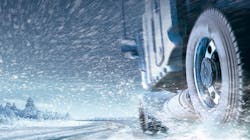“For every 10 degrees Fahrenheit the temperature falls, tire pressure is also falling between two and three psi,” explained Judith Monte, vice president of marketing and customer success at Aperia Technologies.
This can cause all sorts of havoc on the tires, which at best will diminish fuel efficiency and performance, and at worst could lead to a blowout event — both an expensive and dangerous proposition. Half of all roadside emergency calls are due to tires, Aperia reported in its white paper, "Give Your Tires a Snowball's Chance This Winter."
The underlying message is that winter tire maintenance may seem simple enough, but there are several variables that can damage tires and cause fleets a lot of headaches.
“To position yourself for success, it really comes down to the basics,” Monte said, which starts with keeping tires inflated to compensate for that loss.
A leading factor for a blowout is warmer temperatures of spring and summer months, as heat is a tire’s “number one enemy,” but Monte said it’s the cold of winter that begins the tire’s discontent.
That’s why in the spring you may see more “road gators,” or strips of ripped tire, adorning the interstate: months of cold followed by the shock of heat.
Moisture can form condensation that gathers in the tire valve and freezes. That expansion pushes open a pathway for air to escape, this reducing the tire pressure. The cycle of expanding and contracting of the tire itself can damage an improperly maintained, or underinflated, tire. That makes the tire more brittle and exacerbates wear.
“When that happens the rubber, the compounds, start to break down and they really start to change shape,” said the 20-year trucking industry veteran.
This is a very basic explanation of the thermodynamics going on inside the tire, and it has a simple solution that any trucker should already do pre- and post-trip. Check the tread depth for wear and tire pressure for proper inflation.
For tread depth, in a pinch drivers have oft relied on a nickel or quarter. If the president’s head is buried in the tread, that means it’s good to go. Monte scoffed at such a low-tech method being used when tire depth gauges will provide specific results. She also warned that truckers who may have had a blowout this year and gotten roadside replacement need to check that the new tire has the same tread depth as the other tires to avoid uneven wear
“One tire is going to be carrying much more of the load, making that wear much more quickly, heat much more quickly, fail and lead to unsafe situations,” she said.
Tire pressure issues may not be so simple to address, as according to Aperia, almost one in five truck drivers (17%) don’t check inflation correctly, while half aren’t even sure what the correct psi should be.
“It’s really hard to manually manage tire pressure,” Monte said. “The training is not there.”
Faulty tribal knowledge could be the problem. Some drivers still rely on the swing of a baseball bat and how it sounds to verify pressure, rather than a proper gauge or tire pressure monitoring system. Monte said Aperia has conducted experiments to vet the efficacy of a bat, as former drivers who work for Aperia swore tire thumping is a valid method.
Monte said Aperia had them hit tires ranging from properly inflated, overinflated, and underinflated to the point of being nearly flat and by sound alone, the drivers could not consistently identify proper inflation. She pointed out even a simple inexpensive tire gauge could solve the problem and takes up a lot less room than a bat. New drivers should still be properly trained on how to use these gauges and what the optimal psi is, though.
Automatic tire inflation systems would remove any doubt, though they are far more expensive than a $20 gauge. About 70% of new trailers come with these systems, and Aperia offers an automatic inflation device called Halo that bolts onto tractor tires to keep those consistently filled.
Aperia also offers Halo Connect, a digital solution to monitor tire pressure across a fleet. A solution like this allows fleet managers to optimize a specific truck’s tires to the duty cycle, as opposed to employing a one-psi-fits-all approach, such as only spec’ing 100 psi tires, because it maintains uniformity and can be managed easier.
“They no longer have to discount on the manual intervention, so you're no longer having to spec the one standard across the fleet,” Monte said, which opens up a fleet manager’s ability to use tire load tables, which apply a rating related to how much weight can be carried by a specific tire make and model.
While coins and bats were once tools of the trucking trade, Monte believes there are no substitute for digital data. Aside from basic temperature drops, variables such as how the sun is shining can affect how a tire heats up.
“It's hard for even the very best trained and the best performing drivers to just manually manage something that's so important,” Monte said.
About the Author
John Hitch
Editor
John Hitch is the editor-in-chief of Fleet Maintenance, providing maintenance management and technicians with the the latest information on the tools and strategies to keep their fleets' commercial vehicles moving. He is based out of Cleveland, Ohio, and was previously senior editor for FleetOwner. He previously wrote about manufacturing and advanced technology for IndustryWeek and New Equipment Digest.


